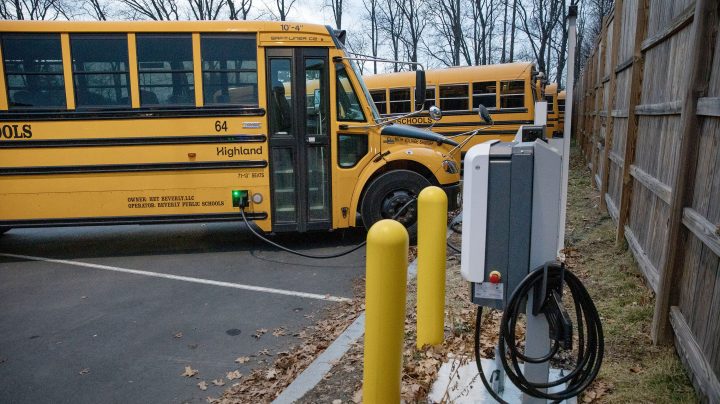
Steadily (and quietly), more electric school buses are getting on the road
Steadily (and quietly), more electric school buses are getting on the road

In the one school bus lot in Beverly, Massachusetts, about an hour north of Boston, driver Henry Birkemouse starts up one of the district’s two electric school buses. After the initial beeping stops, a green light on the dashboard tells Birkemouse that he can hit the accelerator.
Making the shift from a diesel bus was relatively easy for this veteran bus driver. These new buses have a slightly different braking system, but the rest was a direct translation.
“It operates the same as any other bus,” explained Birkemouse. “The thing is, it drives sort of like a golf cart.”
The engine sound — or lack thereof — is one of the first things you notice about these buses. When Birkemouse accelerates, it’s hard to hear the high-pitched hum of the engine.
The electric buses in this lot look just like the standard yellow ones here that run on diesel, except for the black lettering on the hood that reads: HIGH VOLTAGE.
They’re nearly 60% more fuel efficient, according to the Environmental Defense Fund, and much better for the health of staff and kids. Dana Cruikshank, the transportation director at Beverly Public Schools, knows firsthand how intense the exhaust can be in the bus lot.
“When I’m walking in and around all of those running diesel buses, I could really smell the fumes,” he said. “There’s no fumes on this bus at all.”
Beverly Public Schools will get three more electric buses this spring. And officials there hope to transition all of their 27 buses by 2033.
Transition plans like the one in this school district are part of a shift in the electric school bus market. For most of the last decade, these vehicles have struggled to gain traction in the school transportation market since the first one hit the road in California in 2014.
The main reason is cost. New electric school buses can run around $350,000 — two and a half times the price of one that runs on diesel or gas. But thanks to a flood of new funding options, a lot more electric buses are starting to hit the road.
For the last three years, Beverly has been getting logistical and financial help with its EV transition from an electric transportation financing startup called Highland Electric Fleets. And it just so happens to be down the street from school district headquarters.
This school district was a proof of concept for Highland after working mainly with smaller government vehicles. The company buys the buses using some of the $250 million private capital it’s raised, then leases them to the district for the same price that a diesel bus lease would cost.
“That gives us a good amount of runway to go out and try to convince people that this is a good thing to do and this is the right time to do it,” said Amy McGuire, the company’s director of market development.

McGuire explained this model is profitable because electric buses are about 30% to 50% cheaper to run and maintain, adding that it’s a good long-term investment.
“The more we can get school buses on the road, the more the market grows and the technology cost goes down,” she said.
In addition to Beverly Public Schools, Highland Electric works with schools in about 30 other states and three Canadian provinces. And Highland has competition now from other startups.
There’s also a lot of government money at stake. Last summer, the Environmental Protection Agency announced it would give out $5 billion in grants as part of a clean school bus initiative.
“There’s a lot of opportunity with federal investment right now to support school districts in transitioning to electric school buses,” said Laura Schifter, a senior fellow with The Aspen Institute’s Energy and Environment Program.
Schifter added that states and utilities are also helping out. California, for example, committed $122 million in subsidies last year, while Colorado offered $65 million. A handful of other states also have subsidy programs in the works.
“This is really going to spur a lot of action and help our school districts build the capacity with charging, and help our workforce learn how to maintain and operate these buses,” Schifter said.
Of the 480,000 school buses driving on U.S. roads only about 1% are electric. But more are expected to come online soon, with 12,275 new bus commitments from districts as of March 2022. There are also signs that production and delivery are speeding up. Every major bus manufacturer now offers an electric model with many planning to increase their production this year.
There’s a lot happening in the world. Through it all, Marketplace is here for you.
You rely on Marketplace to break down the world’s events and tell you how it affects you in a fact-based, approachable way. We rely on your financial support to keep making that possible.
Your donation today powers the independent journalism that you rely on. For just $5/month, you can help sustain Marketplace so we can keep reporting on the things that matter to you.

















